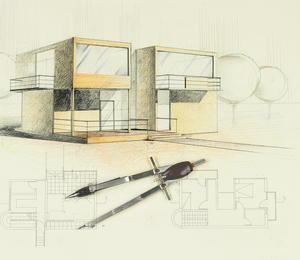
Blog
Foundations of a Worldview: An Architect's Perspective
By Joanna Stephens
Architects have an intense passion for what they do. Although the design profession includes aspects of various worldviews, this common passion stems largely from one of architects' most deep-seated motivations: a Platonic search for truth and the quest to make this truth known to the world through what we build. In the industry, one way this desire is altruistically labeled is “improving the population's visual literacy”. A large part of architectural education is learning (or relearning) “how to see” – intensive training observing buildings, drawing, modeling and cultivating an aesthetic sensitivity. With this acquired understanding of beauty and order, architects can then show people how to better “read” their physical environment by synthesizing these universals into tangible projects that affect people's everyday lives and bring them in touch with truth through good design. Recalling Plato’s Allegory of the Cave, it’s a noble hope to liberate illiterate captives, but one where architects are creating the shadows on the cave wall, casting themselves as the ultimate arbiters of artistic appreciation.
Many of my peers struggle with this sense of working nobly but wanting to be recognized for their contributions to the world, emulating the architects that young professionals study and revere. In the past, Palladio, Wren, Wright and Kahn were deemed masters, a label that was a construct of both their own achievements during their lifetimes and the art historians who shaped their legacies as builder-poets. All have made beautiful buildings, but have also cemented beautiful reputations.
Today, Gehry, Foster, Hadid and many others publicly shun such labels to preserve the link between nobleness and a "it's not about me, it's about the work" brand of humility. Nevertheless, they are catapulted to massive media recognition and given unprecedented creative power to shape our buildings and cities. Masters, yes, but more than just that. The preferred postmodern label? Star-chitects. A clever name, really, denoting an elite class of talented, aesthetically enlightened designers leading the rest of the profession toward excellence and innovation, while belying society’s veneration of fame and influence.
Don't get me wrong, I love some of their work. LOVE it. It was what hooked me on architecture and has powerfully shaped my understanding and appreciation of beauty, order and man's ability to synthesize something higher and more wonderful than the raw materials he works with. Similarly, I want everyone to know and experience this revelation even if they aren't architects, just everyday occupants and observers. With advances in technology, aesthetics, and awareness enabling ever more daring designs, we have only grazed the surface of how beautiful this world can be.
But we as a profession have taken on the aspirations of architecture as beautiful, inspiring and powerful and let them go so far that the quest for truth replaces Truth itself – the quintessential definition of an idol. One of my favorite quotes is from Louis Kahn, one of the 20th century's most significant, inimitable architects, whose body of work has shaped entire generations of designers, myself included. His words resonated with me as I was developing my own love affair with architecture and now, in the light of Christ, show me how easily any earthly love can be elevated to a primary one. In one of his many lectures exalting the transforming power of art, beauty and the actualization of its potential, he paused, put up a slide, and in the height of hubris and the wistfulness of worship posited: "The sun never knew how great it was until it struck the side of a building."
I don't know if Plato would agree, but surely he couldn't deny the resonance of such a claim. It is clear here where truth lies – not in the natural order, creation law or God’s authorship, but in man's achievement, man's struggle, man's search for and understanding of objective truth, manifested in what he makes. For Christian architects, in our worldview struggle, the question is: who are we making it for? If we're not careful, our passion for architecture will have us fall all too easily into Kahn's misdirected worship, and the light of the Son will be subjugated to the mere buildings he shines upon.
